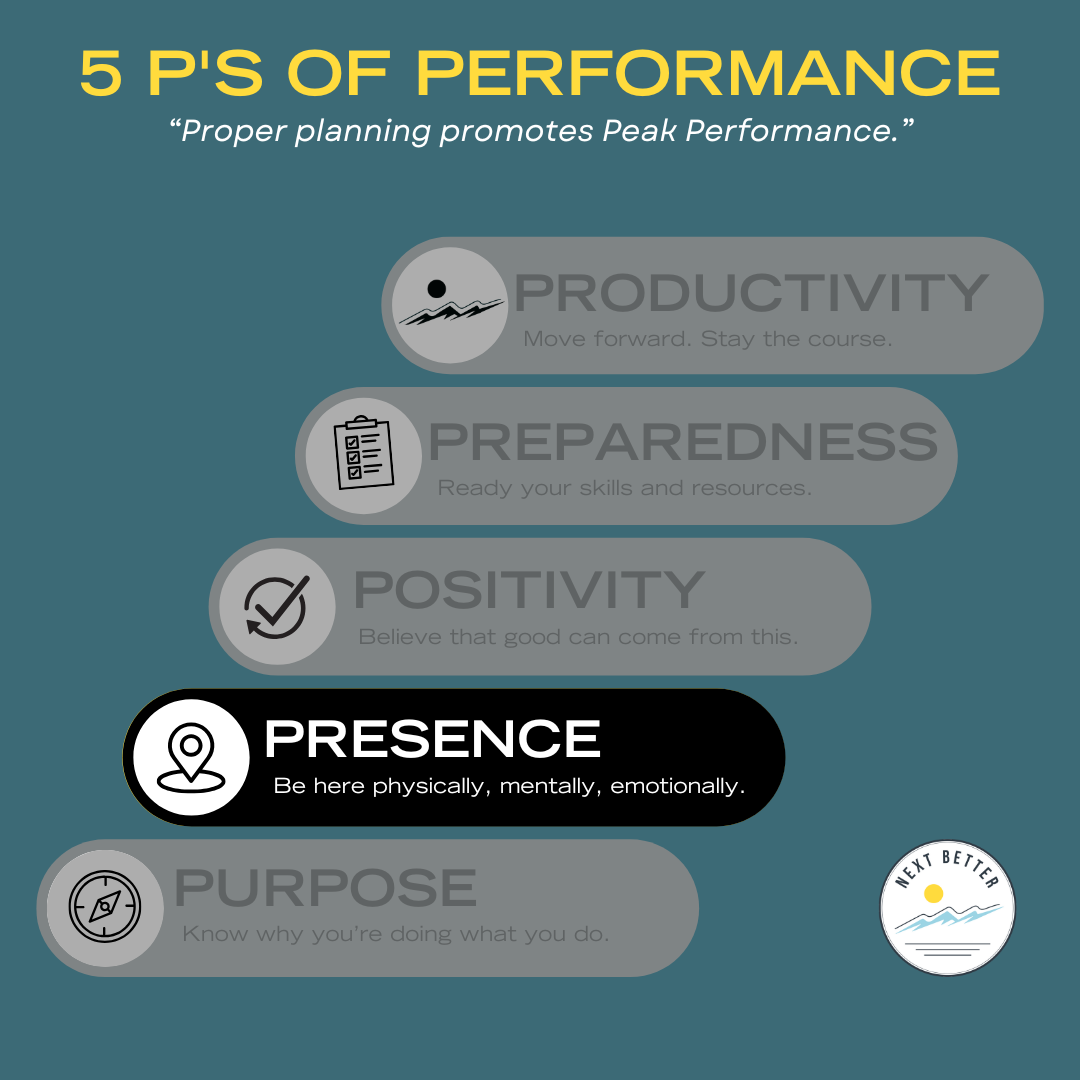Presence: Until You’re Here, You’re Lost
This is Part 2 of a 6 Part Series: The 5 P’s of Peak Performance. Click the name to see an overview.
I remember walking down the hallway of my university one afternoon, walking past table after table of students deep into “studying.” As I passed a row of them waiting for their lecture, something caught my eye—laptops open with notes on the screen, earbuds in place... and phones laid right across their keyboards, streaming the latest Netflix episode.
Not just one student. Not just one time.
It was everywhere.
They were technically there, but mentally, they were a world away. Distracted. Split. Half-invested in studying, half-invested in entertainment, and likely 100% stressed about both.
It’d be easy to chalk it up to college kids being college kids. But let’s not pretend we aren’t doing the same thing as adults.
What Presence Actually Looks Like (and What It Doesn’t)
It looks like the business owner who says their family is their priority—while answering Slack messages during their kid’s soccer game.
It looks like the high performer who blocks off time for deep work—but “just checks” their inbox every five minutes and ends up knee-deep in other people’s priorities.
It looks like anyone who is technically present but not fully engaged—physically in one place, mentally spinning somewhere else.
Sound familiar?
We’re Everywhere—Except Here
The average human has 60,000 thoughts a day.
90% of them are repeats.
85% of them are negative.
If you’ve ever wondered why you feel exhausted even when nothing technically happened, it’s probably because your brain has been working overtime cycling through what went wrong yesterday and what might go wrong tomorrow.
And in the process, it skips right over the only time you can actually do something about your life: the present.
The Cost of Absence
When we’re not present, we:
Miss the meaningful moment our kid wanted to share
Waste the one focused hour we had set aside for progress
Show up to the meeting, but leave without real connection or clarity
And when those moments pile up, we start to feel it.
We don’t feel as effective. We lose clarity. We fall behind—not because we’re not trying, but because we’re not available.
Presence isn’t about perfection. It’s about engagement. And the truth is: performance begins only when we fully arrive.
What Keeps Us From Showing Up
Three core disruptors keep us from presence:
Distraction – Our devices are engineered for addiction. We don’t just scroll; we disappear.
Discomfort – We avoid the present moment because it’s awkward, overwhelming, or uncertain.
Disconnection – We don’t know how to transition between roles (worker, parent, partner, friend), so we carry baggage from one into the next.
These aren’t moral failures. They’re human defaults.
But they’re also deeply unproductive—especially for those chasing excellence.
Practical Ways to Practice Presence
Here are three go-to strategies I share with clients who want to be more present—and perform better because of it:
Create Mindful Transitions
Before switching contexts (from work to home, from meeting to solo work, from day to evening), take 60 seconds to reset.
Close your laptop and take 3 deep breaths.
Ask: What deserves my full attention right now?
Use a trigger—like walking through a doorway or pulling into the garage—to cue a shift in focus.
Build “Mental Resets” Into Your Schedule
Before focused work or a big conversation, take 2 minutes to:
Close tabs or apps you won’t need
Silence notifications
Imagine the most meaningful outcome of this time
Center your energy around that intention
Audit Your Environment for Distraction
Be honest: what’s constantly stealing your presence?
Keep your phone in another room during important work
Use full-screen mode to limit visual clutter
Use noise-cancelling headphones or ambient music if needed
Face away from windows or foot traffic if you're easily pulled into people-watching
These aren’t hacks. They’re habits. And they build a mind that’s ready for performance—right here, right now.
Performance Starts With Showing Up
Presence is the second P in the 5 P’s of Peak Performance, but in many ways, it’s the first domino. Because once you’ve defined your Purpose, if you don’t show up fully, you’ll miss the chance to live it out.
And here's something I tell my clients all the time:
If it’s on your calendar, and you were purposeful in putting it there, it’s worthy of your full attention.
Whether that’s a meeting, a writing session, a workout, or your kid’s basketball game—be all there.
One Next Step to Practice
Choose one moment today to practice being fully present.
Not a whole day. Not a whole hour. Just one moment.
Put your phone away. Breathe.
Ask yourself: “What deserves my focus right now?”
And be where your feet are.
Want help building a life of Purpose, Presence, and Performance?
Let’s talk. Together, we can identify the distractions, habits, and systems that either anchor you or pull you away—and create a plan to perform at your highest level, with clarity and intention.


